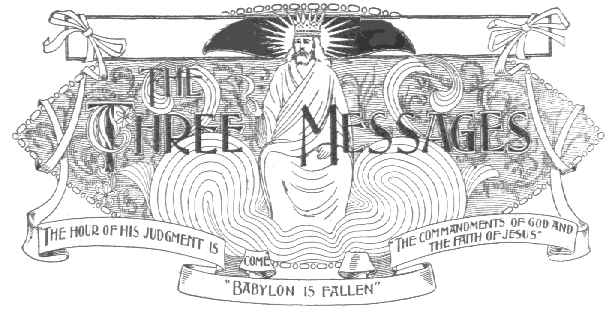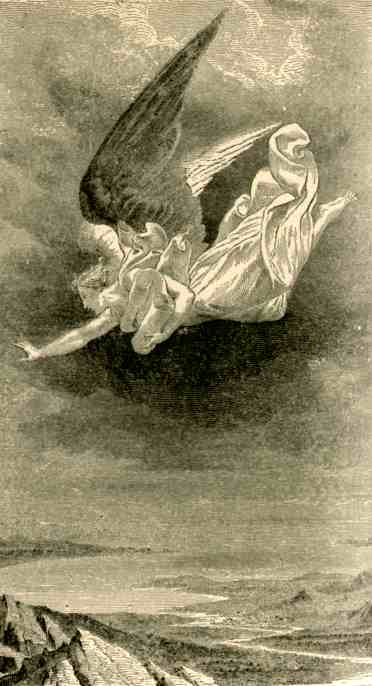

Greek allos aggelos. Why “another”? Consider several points: ![]() The
144,000 mentioned in verse 1 may be seen as the same group of people as
is represented by the angel here but we would expect the text to read “the
same angel.”.
The
144,000 mentioned in verse 1 may be seen as the same group of people as
is represented by the angel here but we would expect the text to read “the
same angel.”. ![]() Many
angels have been mentioned earlier in the book. The previous angel is the
one of chapter 10 whom we saw as Christ. Allos means “another of the same
kind.” Christ is clearly different.
Many
angels have been mentioned earlier in the book. The previous angel is the
one of chapter 10 whom we saw as Christ. Allos means “another of the same
kind.” Christ is clearly different. ![]() The second angel (v.8) is introduced as "another."
The second angel (v.8) is introduced as "another." ![]() The
text would read essentially the same without “another” and is so translated
by The World English Bible.
The
text would read essentially the same without “another” and is so translated
by The World English Bible. ![]() However,
we do find similar angels who bore messages to the seven churches—messenges
of encouragement and correction.
However,
we do find similar angels who bore messages to the seven churches—messenges
of encouragement and correction.
As the 144,000
Look at our verse again.
"And I saw another angel fly in the midst of heaven. . . ." The only candidate
for the similar "angel" in our context is the 144,000. In fact, they have
been the subject of the whole set of verses. Thus when John said he saw
"another" angel, we may easily understand it to be the unmentioned one
who represented the 144,000 on Mount Zion playing harps and singing with
no guile and no fault. The case for the previous angel being the 144,000
is not as strong and clear from the text as is the angels sent to the seven
churches just mentioned. We can accept both the 144,000 and the churches
angels.
As faithful ones who received John's
letters and who guided their people
While there were seven
literal churches which received the letters John was inspired to write,
the churches clearly represent historical periods of the Christian church
concluding with Laodicea, the church of our day, which is described as
feeling no need. In practically all the churches some were faithful and
some were not. The faithful ones held the torch of truth. Symbolized as
angels [aggelos] they, through the leading of the Holy Spirit, provided
direction for their church and the church of the next period.
| The first angel | flies in mid-heaven | speaks with a loud voice | calls all to worship God |
| The previous "angel" | heard from heaven | voice of waters and thunder | praises God for justice and mercy See on v2 |
Does it still seem strange
that the previously seen "angel" who was like the judgment angel of 14:6
is the 144,000? Remember that we discussed a similar situation in connection
with the third evil force in chapter 13. The three are 1
dragon,
2
beast from the sea, and 3
beast
from the earth — a false trinity, re13tr.
In 13:13 we saw the beast from the earth calling fire down from heaven
to deceive the earth dwellers. He was pretending to be the prophet Elijah
that God said would return before the great and terrible day of the Lord
(Mal. 4:5),
re1313.
We see the false trinity
again in re1613. Here the
third member is seen as the false prophet. The earlier symbol (beast from
the earth) identifies him by his origin. In the latter symbol (false prophet)
we are reminded of his deceptive ministry of miracles.
Similarly, God's sealed people
living on the earth at the end of time are compared to purified Israel
under the symbol of the 144,000. Their role as end-time messengers of mercy
is emphasized under the symbol of the previous angel.
14:6, note on timing
Messages for
particular times
The literary structure of the text reinforces the connection between the 144,000 and the three angels. In comparing the description of the 144,000 (verses 1-5) with the rest of the chapter where we find the three angels, we notice something interesting.
The calls of the three angels,
particularly the third, which describes the wrath to be poured out on those
who choose to follow the beast and his image, are given in anticipation
of the decision facing every living human. These messages would then come,
in time, before the victory (and sealing) of the 144,000 redeemed ones
which we have already seen in the first five verses of the chapter.
This is an example of a literary
pattern consistently seen in the book of Revelation. The pattern has
two blocks of text. First, a brief theme statement is made. That theme
is then followed by a larger block of text explaining how it came to be.
Here we have the 144,000
with the Lamb, described in verses 1-5. The explanation begins with verse
6 and continues through the rest of the chapter. In this larger block of
text, we hear the three angels (vss. 6-13). Then we see the salvation of
the righteous (grain harvest, 14-16) and the punishment of the wicked (the
grapes trampled, 17-20). This reveals how the 144,000 got to be on Mount
Zion, redeemed from being trampled in the winepress by heeding the voice
of the third angel.
This means that the 144,000,
although not mentioned as such, are involved in the drama of the three
angels. And we may stand among them, by God's grace.

14:6 b
Flight plans
"And I saw another angel fly in the midst of heaven, having the everlasting gospel to preach unto them that dwell on the earth, and to every nation, and kindred, and tongue, and people, Saying with a loud voice, Fear God, and give glory to him; for the hour of his judgment is come: and worship him that made heaven, and earth, and the sea, and the fountains of waters." (Rev. 14:6, 7)
To understand the messages of the three angels, we need to know whether they fly at certain times in history and if so, when. The first angel, in verses 6 and 7 above, announces the hour of judgment declaring it to have come, so he flies specifically as a judgment begins. The second angel declares "Babylon is fallen, is fallen" so he flies after the symbolic city has fallen. The third angel, however, follows the first two. Let's read some of his message.
"And the third angel followed them, saying with a loud voice, If any man worship the beast and his image, and receive his mark in his forehead, or in his hand, The same shall drink of the wine of the wrath of God, which is poured out without mixture into the cup of his indignation. . . ." (Rev. 14:9, 10)
Notice that the first angel
tells what is happening as he flies. The second tells what has apparently
just happened. And the third tells what will happen in the future. In other
words, the third angel flies before God's wrath is poured out unmixed with
mercy. Because he follows the first two, we see all three in the sky during
the time of his message. So what is present tense as the first angel appears?
The period of judgment — the opening of the seals. When the judgment is
over, we no longer see the three angels. Then the four winds blow and the
punishment of wrath predicted by the third angel, occurs.
The table below shows successive
events as they relate to the flying of the angels. This will become clearer
as we study. Also, the preadvent judgment is not the only one described
in the Bible.
|
|
|
|
| Before they fly (most of earth's history) | Before the judgment begins | Heb. 9:27, 28 |
| 1st angel | Judgment begins | Rev., 14:6; 1 Peter 4:17 |
| 2nd joins the first | Babylon is fallen | Rev. 14:8 |
| 3rd follows (All three messages heard together) | God's final warning as beast and image threaten | Rev. 14:9-12 |
| Angel of great power and light (last part of the time of the three angels) | Last call given — the even stronger message | Rev. 18:1-6 re1801 |
| No angels of mercy | Wrath of God (7 last plagues) | Rev. 15, 16 re15 |
| Never another call | Jesus takes us to heaven | Rev. 1:7; John 14:1-3 jn1401. |
|
|
|
|
|
|
|